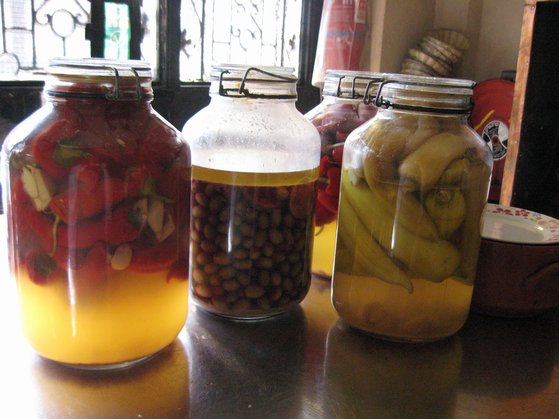The tastiest olives are the ones you pickle yourself. Read on for ways of upgrading store bought olives too.
Olives are eaten with almost every meal in the Middle East, sometimes even at breakfast. Organically grown olives are the most delicious. You might be growing an olive tree in a container, but be realistic. If your tree gives fruit, there will probably not be enough for pickling.
Dried and salty or plump and succulent, glowing in gem-like green, black, brown, and purple, olives have their own displays in supermarkets and open-air markets everywhere (see Karin’s post on Israeli fresh food markets). Some people like their olives hot with fiery chilis. Some prefer them tangy with preserved lemons, or mellowed with bay leaves. You can pickle and season fresh olives by the kilo if you want, and it’s not hard.
It’s in autumn that olives are harvested and appear in the markets. But if you missed the season, a recipe for improving supermarket olives follows this one.
The olives sit in plain water, changed daily, for a week. During that time their original bitterness will leach out into the water. In the following 4-8 weeks, they marinate in fresh brine and seasonings.
Ingredients for fermented (pickled) olives:
1 kilo fresh olives
water
After a week, you will need:
Fresh water
Salt
Olive oil
4 cloves garlic, peeled and halved
1 lemon, sliced
chili peppers to taste
2 bay leaves
Optional: oregano, thyme, rosemary, grains of black pepper, allspice
Equipment:

Knife or clean rock
Mason jar or other large jar with a tight-fitting lid
Rinse the olives and drain. Discard any spoiled ones.
Either cut three slits in each olive or crush them with a clean rock, a few at a time. If crushing, only press hard enough to crack them open, not mash them.
Put the olives in the jar. Cover them with water. Make sure there are none floating – weigh them down with a small saucer or drape a clean recycled plastic bag over the surface of the water to keep them under.
Change the water every 24 hours. Do this for a week.
The olives will lose their bright color as their bitterness leaches out. When the olives are uniformly darker, taste them to judge if they’re ready for brining. If they’re still bitter, soak them and change the water for another few days.
Once the olives are ready, drain them and put them in a large bowl while washing out their jar. Make a brine. This is 1/4 cup kosher salt to 4 cups fresh water.
Mix well.

Replace the olives in the clean jar. Pour the brine over all. Add herbs and spices to taste.
Cover the olives with plenty of olive oil (as in the image above) to exclude air and prevent spoilage. Close the jar. You can use the olive oil later.
Leave it alone for a month, then taste an olive every week or so till you’re satisfied.
Always remove olives for serving with a clean, dry spoon. Keep the majority in their brine and seasonings – they will only improve.
How To Make Cheap Olives Delicious

Make your own tasty marinade, no matter what olives you have at home.
Pour out the brine they came in, and as above, season with garlic, peppers, bay leaves, and lemon. Pour 1/4 cup dry red wine over them if you wish. Cover them with olive oil. Store in the fridge and eat after 1 day to allow the flavors to penetrate. The olives will stay good 1 week.
Enjoy!
More about olives and olive oil on Green Prophet:
Olive Oil Pioneer Fixes His Heart





It tastes better with more bay leaves.
Yes, that’s a tried a true method, Filo.
Another way to determine the determine the correct amount of salt is to add enough salt until an egg floats